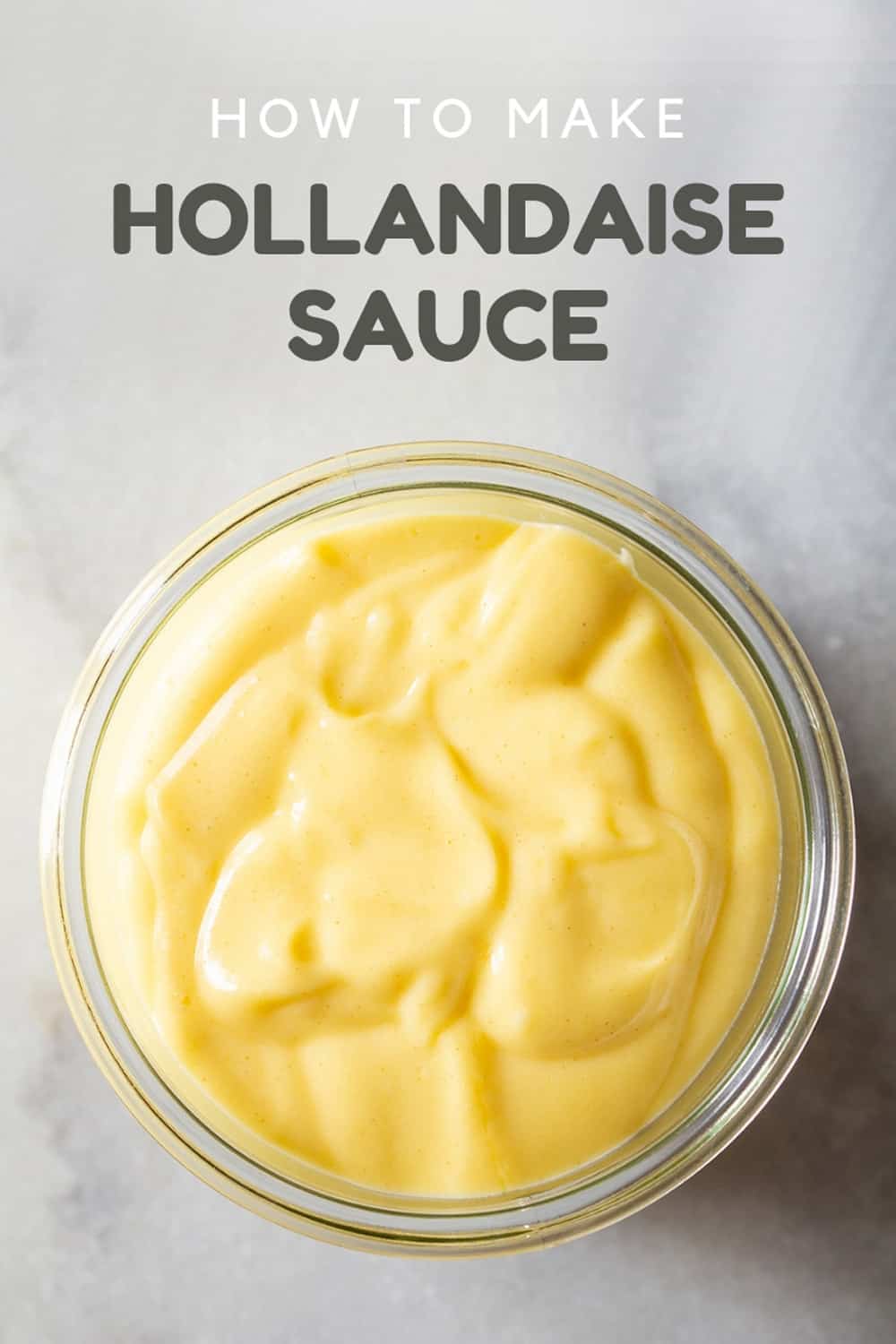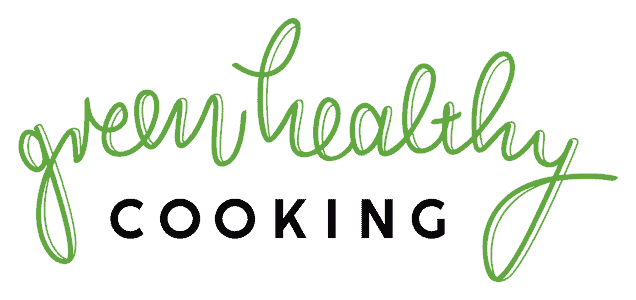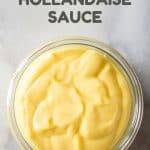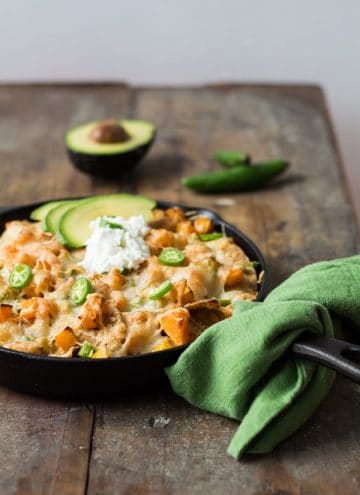Hollandaise sauce is a must-have for the perfect eggs Benedict, and it’s delicious on asparagus and fish, too. This is the easiest recipe for making the classic sauce at home, with no fuss or mess!

What is hollandaise sauce?
Hollandaise is one of the five basic mother sauces, sharing the spotlight with bechamel, veloute, tomato, and Espagnole sauces. It’s a rich, creamy sauce made by emulsifying egg yolks, melted butter, lemon juice or vinegar, and spices. The ingredients for the sauce are whisked together in a bowl, set over a pot of simmering water, until the eggs are cooked and a thick sauce forms.
There is no doubt that learning how to make hollandaise sauce will help you impress everyone sitting at your weekend brunch table. For whatever the reason, people tend to feel fancy when eating eggs Benedict. Aside from that, the rich, velvety smooth sauce is incredibly delicious over vegetables, especially asparagus and broccoli!

Is it safe to eat raw eggs?
Although some people eat raw eggs for the high protein value, there is a risk of Salmonella bacteria being present in uncooked eggs. According to the CDC (Center for Disease Control and Prevention), Salmonella is responsible for 23,000 hospitalizations and 400 deaths a year. For that reason, some people have concerns about the fact that the eggs in Hollandaise sauce are only partially cooked.
The real question is, can you get Salmonella from eating hollandaise sauce? While the possibility of it does exist, it is not likely to happen. Here are some facts to consider:
- According to the FDA, eggs qualify as “safe” to eat once they reach an internal temperature of 160 degrees Fahrenheit. At that temperature, the heat will kill any Salmonella bacteria.
- Facts on the American Egg Board website state that the risk of an egg being contaminated with Salmonella are 1 in 20,000. In other words, you would have to eat an awful lot of eggs to find that golden ticket.
- The classic hollandaise sauce recipe, originating in France, called for raw eggs, straight from the farm. To prevent the risk of foodborne illness, many chefs and cooks nowadays use pasteurized eggs to make hollandaise. The pasteurization process uses very high heat, so any bacteria present will be killed off.
When you make a hollandaise sauce recipe, simply use common sense and proper food handling and you should be just fine.

What consistency should Hollandaise be?
The perfect hollandaise sauce is smooth, slightly glossy looking, and pourable. If you notice a grainy appearance, it’s a sign that your sauce is “broken”, meaning, the ingredients have separated. If this happens, know that it happens to just about everyone at one point or another. The good news is, you may not need to toss the sauce – broken hollandaise sauce can sometimes be fixed!
To fix the broken sauce, you can try one of two things:
- Whisk a teaspoon of boiling water, one drop at a time, into the broken sauce, OR
- Place one egg yolk into a large bowl and very slowly whisk the broken hollandaise into the bowl.

Hollandaise Sauce
Ingredients
- 1/2 cup butter, melted - 1 stick, 113g
- 1 tsp dijon mustard
- 1 Tbsp lemon juice
- 2 egg yolks
- salt/pepper - optional
Instructions
- Melt the butter over low heat until almost all liquid. Remove from heat right before it's all melted and stir until completely melted. Transfer into a container with a spout.
- Separate eggs and put egg yolks in a bowl that fits over a small pot without touching the pot's bottom.
- Add dijon mustard and lemon juice to egg yolks and salt (pepper) if using unsalted butter and whisk until smooth.
- Bring 1 cup of water to a low simmer in a small pot and once simmering add bowl with egg yolk-mustard-lemon mixture on top and whisk constantly until slightly warm.
- Pour butter in a very thin steady stream to the yolk mix while continuously whisking. NEVER STOP WHISKING.
- Depending on how liquid and pourable or thick you want your hollandaise you either remove the sauce from the heat right away or keep whisking for a couple more minutes. When you ALMOST reached the consistency you like, remove from the heat and still continue whisking, it will thicken up still a little bit more. See video.
Nutrition



 Lemon Orzo Salad
Lemon Orzo Salad Butternut Squash Nachos
Butternut Squash Nachos Oven Roasted Vegetables
Oven Roasted Vegetables
Tom Hyde says
followed to a t .. not thick, odd mustard taste .. not good
Lorena Grater says
Dear Tom, did you use “Dijon” mustard? And really just 1 teaspoon? I find it hard to believe that one teaspoon of mustard can overpower half a cup of butter, two egg yolks, and lemon juice. Did you watch the instructional video and follow that?
Teri says
Thank you so much. I ever thought I’d be able to make homemade hollandaise and was destined to using the package mixes. Your step by step and explanation really helped and I got it the first time,
Donald Watson says
I checked the internet regarding the “FDA” mentioned in this article. This appears to be one of those inferior government agencies located in the United States, and as such should not be considered as credible information regarding food safety and/or preparation. Please make sure to check with professional for profit organizations before making all culinary decisions.
Dr Rebecca Greer says
Made this first time and it curdled. I used double boiler but I think water too hot and pan not right shape. I made crab cakes and wanted this sauce so…..I made it again. I used a bowl and it not touching water and temp of water just simmering. Came out perfect!!!! Taste is so so good. Is an easy recipe ! I would send you a pic but don’t see place to use attachments
Sabrina says
Hi, I love your videos!! I am about to make this. How long does it keep for?
Lorena Grater says
Technically it keeps several days. Meaning, it’s perfectly safe to eat for several days. However, once you put it in the fridge it hardens because of the butter and if you want to make it creamy again it’s really really difficult and you risk it curdling. I recommend making a half batch if you don’t think you’ll finish a whole batch. It’s always best made fresh every time. It only takes a couple of minutes ;)
Safiya farheen says
To be honest I have tried a lot of your recipes almost everything you make is so tasty at the same time they are super duper healthy as well.
Lorena says
I’m so happy to read you like my recipes :D I pour my heart into creating tasty recipes :)
Kristen says
Hi from Québec!
I did not have Dijon, replaced with only 1/2 tablespoon on yellow mustard, and added extra yolk, dash of nutmeg, Yummy!
Gale says
Can you use an electric hand mixer instead of a whisk?
Lorena Grater says
You can but you risk not feeling the consistency properly with a machine. The advantage of using your hand and a whisk is that you feel how the consistency is.